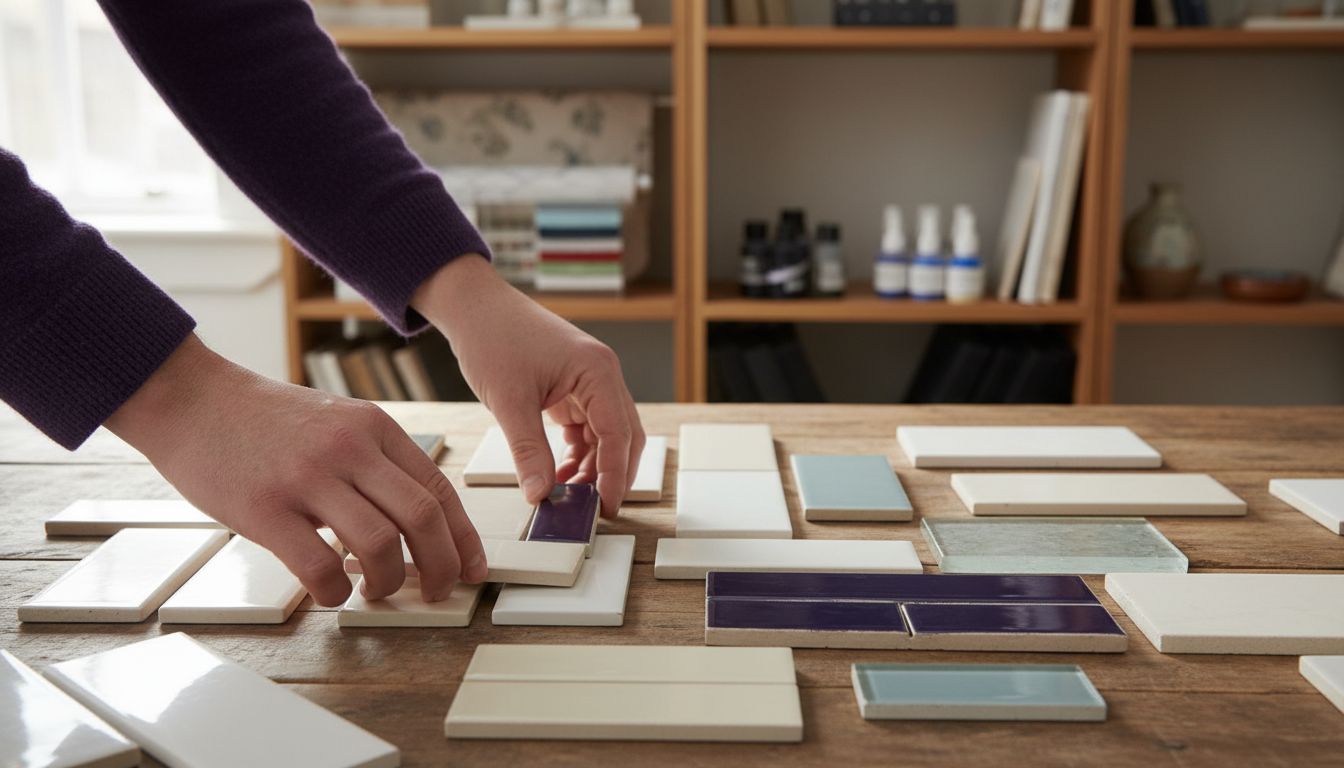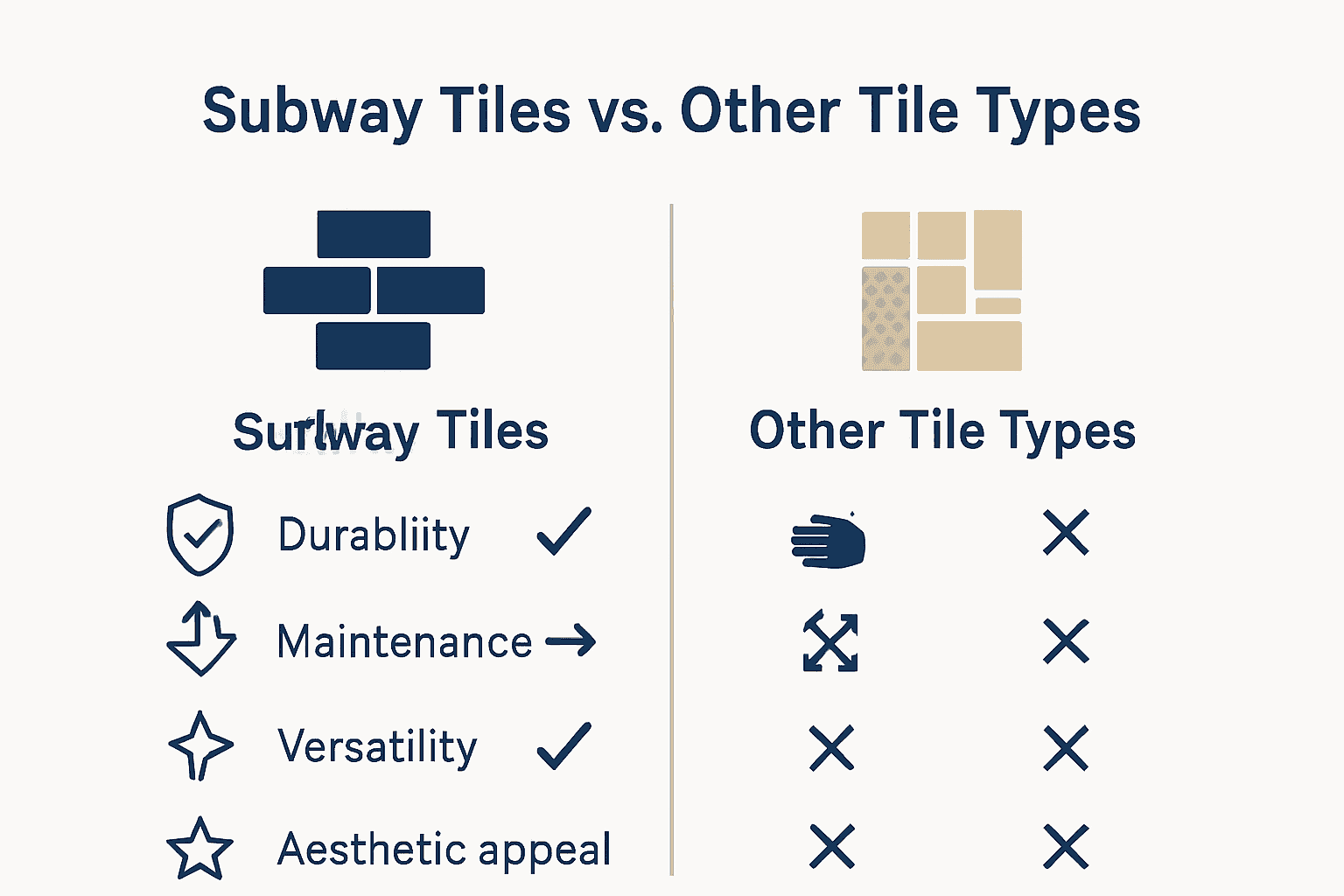
What Is Subway Tile? Complete Guide for UK Homes
Share
More than a century after their debut, subway tiles still define modern interiors with their simple elegance and lasting style. Introduced in New York’s subway stations in 1904, these iconic rectangles became popular for their ability to balance beauty and practicality. Today, their timeless appeal and versatility make subway tiles a go-to choice for kitchens, bathrooms, and beyond. Discover how this classic tile earned its reputation and why it remains a favourite in stylish homes across the UK.
Table of Contents
- Defining Subway Tile And Its History
- Styles, Sizes, And Material Variations
- Key Features And Benefits Of Subway Tiles
- Popular Applications In Uk Interiors
- Comparing Subway Tile To Other Tile Types
- Choosing, Installing, And Maintaining Subway Tiles
Key Takeaways
| Point | Details |
|---|---|
| Historical Significance | Subway tiles originated in New York City in 1904, designed for durability and cleanliness in public transit. |
| Versatile Applications | These tiles are popular in kitchens, bathrooms, and utility spaces due to their moisture resistance and aesthetic appeal. |
| Material and Design Evolution | Subway tiles now come in various materials, sizes, and colors, allowing for creative designs that suit any style. |
| Maintenance and Installation | Subway tiles require minimal maintenance and, if installed correctly, can offer long-lasting beauty and functionality in homes. |
Defining Subway Tile and Its History
Subway tiles represent a classic rectangular ceramic tile design that has transformed interior design since its inception in the early 20th century. Originating in the New York City subway system in 1904, these simple yet elegant tiles were initially created for practical reasons: they needed to be durable, easy to clean, and visually appealing in public transit spaces.
The original subway tiles were pure white, glazed ceramic rectangles measuring 3 inches by 6 inches. Architects George C. Heins and Christopher Grant La Farge designed these tiles for the initial subway stations, selecting white because it symbolised cleanliness and brightness in an underground environment. Their design was revolutionary - creating a surface that could withstand constant use while maintaining a pristine appearance.
Beyond their subway origins, these tiles quickly transitioned into residential and commercial design. By the 1920s, subway tiles had become a staple in kitchens and bathrooms, prized for their simple geometry, reflective surface, and ease of maintenance. Their versatility meant they could be arranged in multiple patterns - the classic brick bond layout, vertical stacking, or herringbone arrangements - providing designers and homeowners with remarkable flexibility.
Today, subway tiles have evolved far beyond their original white ceramic roots. Modern iterations come in various colours, materials, and sizes, from traditional ceramic to sleek porcelain tiles, allowing them to complement virtually any interior design scheme. Their enduring popularity stems from a perfect blend of historical significance, practical functionality, and timeless aesthetic appeal.
Styles, Sizes, and Material Variations
Subway tiles have dramatically expanded from their original white ceramic design, offering homeowners and designers an incredible range of styles, sizes, and materials. While the classic 3-inch by 6-inch white rectangular tile remains popular, contemporary options now include dimensions ranging from tiny 2-inch squares to expansive 12-inch by 24-inch rectangles, providing unprecedented design flexibility.
Material variations have also revolutionised subway tile applications. Traditional ceramic remains a staple, but modern alternatives include porcelain, glass, natural stone, and even metal tiles. Porcelain subway tiles offer enhanced durability and water resistance, making them ideal for high-moisture areas like bathrooms and kitchen splashbacks. Patterned tiles have introduced another dimension, allowing homeowners to incorporate intricate designs within the classic subway tile format.
The colour palette for subway tiles has exploded beyond the original white. Contemporary ranges include everything from subtle neutral tones to bold, vibrant hues. Designers can now select metallic finishes, matte textures, crackle glazes, and even handcrafted tiles with slight imperfections that add character. These variations mean subway tiles can complement virtually any interior design style - from minimalist modern spaces to rustic, traditional environments.

Specific layout patterns further enhance subway tile versatility. Beyond the classic horizontal brick bond, designers now experiment with vertical stacking, herringbone arrangements, crosshatch patterns, and diagonal installations. These creative configurations transform a simple tile into a dynamic design element, proving that subway tiles are far more than just a functional wall covering - they’re a genuine design statement with remarkable aesthetic potential.
Key Features and Benefits of Subway Tiles
Subway tiles offer an exceptional combination of functionality and aesthetic appeal that makes them a top choice for modern interior design. Their fundamental characteristics include remarkable durability, straightforward maintenance, and versatile design potential, making them an ideal solution for various residential and commercial spaces like kitchens, bathrooms, and splashback areas.
Practically speaking, subway tiles excel in performance and practicality. Their glazed surface creates a water-resistant barrier that prevents moisture absorption, making them perfect for high-humidity environments. Easy to clean and remarkably hygienic, these tiles can be quickly wiped down with standard cleaning solutions, resisting stains and preventing bacterial growth. Metro beveled ceramic tiles demonstrate how modern manufacturing techniques have enhanced these traditional tiles’ inherent benefits.
The design flexibility of subway tiles represents another significant advantage. Unlike many decorative elements that quickly become dated, subway tiles offer a timeless aesthetic that can adapt to changing interior design trends. Their simple rectangular shape allows for multiple laying patterns - from classic horizontal brick bond to contemporary herringbone or vertical stack configurations - providing homeowners unprecedented creative freedom. This adaptability means subway tiles can complement minimalist, traditional, industrial, or eclectic design schemes with equal elegance.
Economically, subway tiles present an intelligent investment for homeowners. Their durability means fewer replacements over time, while their classic design ensures long-term visual appeal. Whether used as a kitchen splashback, bathroom wall covering, or decorative feature, these tiles offer exceptional value, combining aesthetic sophistication with practical performance at a reasonable price point. Their ability to visually expand spaces, reflect light, and create a clean, crisp backdrop makes them a versatile design element that continues to captivate interior designers and homeowners alike.
Popular Applications in UK Interiors
Subway tiles have become a transformative design element in UK homes, offering versatile solutions for multiple interior spaces. Their adaptability makes them particularly popular in areas that demand both aesthetic appeal and practical functionality, such as kitchens, bathrooms, and utility rooms where moisture resistance and easy maintenance are crucial.
In contemporary British kitchens, subway tiles serve as stunning splashback solutions that protect walls while adding visual interest. Best tiles for kitchens demonstrate how these tiles can create a clean, bright backdrop that complements various worktop materials and cabinetry styles. White subway tiles remain a classic choice, but increasingly, homeowners are experimenting with coloured and textured variations to introduce personality and depth to their cooking spaces.
Bathrooms represent another key application for subway tiles in UK interiors. Their water-resistant properties and hygienic surface make them ideal for shower enclosures, bathroom walls, and even flooring in wet areas. The traditional rectangular format allows for creative laying patterns - from classic horizontal arrangements to contemporary vertical stacks or intricate herringbone designs - enabling homeowners to create unique visual statements that reflect individual style preferences.
Beyond kitchens and bathrooms, subway tiles are finding innovative applications in UK homes. Utility rooms, conservatories, and even feature walls in living spaces are now being transformed by these versatile tiles. Their ability to reflect light, create a sense of spaciousness, and provide a timeless design element makes them a go-to choice for interior designers and homeowners seeking both practicality and aesthetic sophistication in their living environments.
Comparing Subway Tile to Other Tile Types
Subway tiles distinguish themselves from other tile types through their unique rectangular format, distinctive history, and remarkable versatility. While traditional square or mosaic tiles offer their own aesthetic appeal, subway tiles provide a singular design language that bridges classic and contemporary interior styles with unparalleled elegance.
Compared to ceramic tiles, subway tiles offer more design flexibility and a more streamlined visual profile. What is ceramic tile typically comes in standard square formats, whereas subway tiles’ elongated rectangular shape allows for more creative laying patterns. Ceramic tiles can be bulky and visually heavy, while subway tiles create a sense of spaciousness and light, making them particularly effective in smaller UK homes where visual expansion is crucial.
When contrasted with natural stone tiles, subway tiles present significant practical advantages. Stone tiles often require extensive maintenance, sealing, and can be prone to chipping or staining. Subway tiles, particularly those made from porcelain or ceramic, offer superior durability, easier cleaning, and a more consistent appearance. Their uniform manufacturing process ensures each tile looks identical, creating a cleaner, more intentional design aesthetic compared to the natural variations found in stone tiles.
The finish of subway tiles also sets them apart from other tile types. While some tiles come in highly polished or extremely matte finishes, subway tiles typically offer a balanced, semi-gloss surface that reflects light subtly without being overwhelming. This characteristic makes them incredibly adaptable, capable of complementing various design schemes from minimalist contemporary to traditional Victorian-inspired interiors. Their ability to create visual continuity while simultaneously adding textural interest makes subway tiles a superior choice for homeowners seeking both practicality and sophisticated design.

Choosing, Installing, and Maintaining Subway Tiles
Subway tile selection requires careful consideration of multiple factors beyond simple aesthetic appeal. Homeowners must evaluate the specific requirements of their space, including moisture levels, lighting conditions, and overall design scheme. Key considerations include tile material, finish, colour, and size, each playing a crucial role in achieving the desired visual and functional outcome.
When it comes to installation, precision is paramount. Wall tiling tutorial experts recommend thorough surface preparation as the foundation of a successful subway tile project. This involves ensuring walls are completely level, clean, and free from moisture or structural defects. Professional installers typically suggest using a high-quality adhesive, spacers for consistent grout lines, and a spirit level to maintain perfect alignment. DIY enthusiasts should invest in proper tools like tile cutters, notched trowels, and grout floats to achieve a professional-looking finish.
Maintenance of subway tiles is relatively straightforward but requires consistent care. Ceramic and porcelain subway tiles are naturally resistant to staining and moisture, making them ideal for high-traffic areas. Regular cleaning involves using mild, pH-neutral cleaning solutions and avoiding abrasive materials that might scratch the tile surface. Grout lines demand special attention - sealing grout annually helps prevent moisture penetration and maintains the tiles’ pristine appearance. Homeowners should also address any chipped or cracked tiles promptly to prevent further damage and maintain the overall integrity of the tiled surface.
Budget considerations play a significant role in subway tile selection and installation. While basic ceramic subway tiles can be quite affordable, premium materials like handcrafted or designer tiles can significantly increase project costs. Homeowners should balance their design aspirations with practical financial constraints, considering factors like tile durability, installation complexity, and long-term maintenance requirements. Professional installation typically ranges from £50 to £100 per square metre, though DIY approaches can substantially reduce overall project expenses.
Discover Your Perfect Subway Tile Solution Today
Choosing the right subway tile can feel overwhelming with so many styles, sizes, and materials to consider. Whether you want to create a timeless kitchen splashback or a stylish bathroom wall, the key challenge is finding tiles that combine durability, easy maintenance, and lasting aesthetic appeal. With options like classic white ceramic or modern porcelain in exciting layouts such as herringbone or vertical stacks, your ideal look is within reach.

Explore a wide selection at Vivid Tiles where quality meets affordability. Benefit from expert guidance and free UK delivery to bring your design vision to life without compromise. Don’t wait to transform your home with versatile and elegant subway tiles — start browsing our range and add that finishing touch to your interiors now.
Frequently Asked Questions
What are subway tiles made of?
Subway tiles are typically made from materials such as ceramic and porcelain. There are also modern variations that include glass, natural stone, and metal, providing a wide range of options for different interior designs.
What are the standard sizes of subway tiles?
The traditional subway tile measures 3 inches by 6 inches, but contemporary variations can range from small 2-inch squares to large 12-inch by 24-inch rectangles, allowing for creative design configurations.
How do you maintain subway tiles?
Maintaining subway tiles is straightforward; they can be cleaned with mild, pH-neutral cleaning solutions. It is important to avoid abrasive materials that may scratch the surface. Sealing grout lines annually helps prevent moisture penetration and maintain cleanliness.
What are the benefits of using subway tiles in home design?
Subway tiles offer durability, easy maintenance, and versatile design potential. Their timeless aesthetic can adapt to various styles, making them ideal for areas like kitchens and bathrooms while also reflecting light and visually expanding spaces.